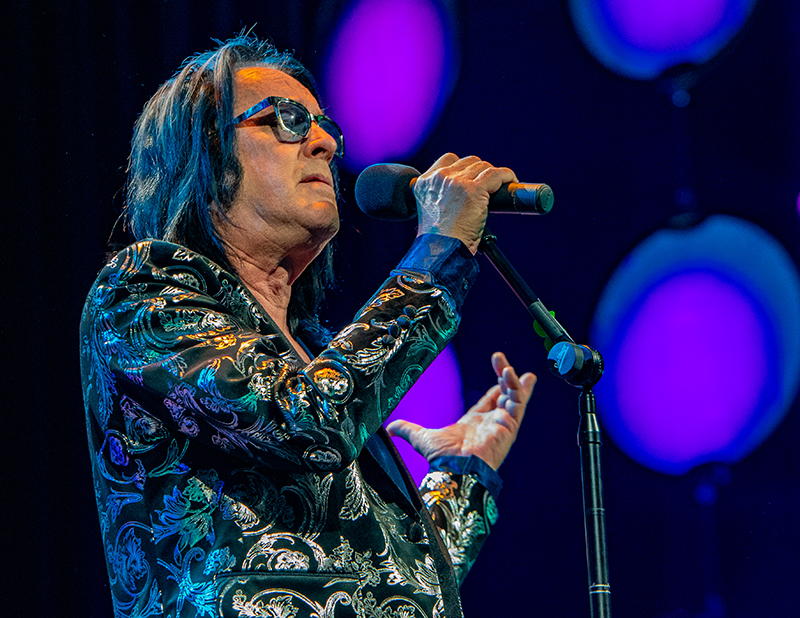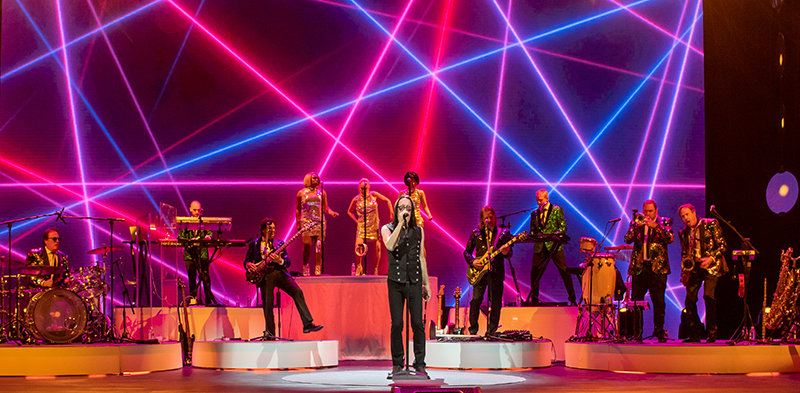
25-City “Tour” from Chicago Gives Performers Reactions from In-Person and Virtual Fans
“It’s way better than nothing,” Todd Rundgren says, of his recent trailblazing “tour.” “Playing at all was the first objective. Next was that it be as close to what we normally do in a live show as opposed to me just sitting in front of a bookcase with an acoustic guitar.” Typical of Rundgren’s entire career, he created an experience like no other, heavy on technology. The results are the Clearly Human Tour. Its 25 performances over five weeks were directed each night at a specific city’s audience. Rundgren and team created the six-minute video loops that ran prior to the show, highlighting whatever city he was “playing in” that night. These included images of local monuments and well-known buildings to local delicacies (i.e., Buffalo NY = Buffalo Wings). He brought out a 10-piece band complete with background singers and brass. The set list drew heavy on his 1989 Nearly Human album, and many other songs from his five decades that could take advantage of a full band like that (opener “Real Man,” with brass and background singers, never sounded better).
While the shows were all broadcast live from Chicago’s Radius theater, each city specified got first dibs on tickets. After a certain amount of time, the “geo fence” was lifted. For $35 a ticket, the audience member can be there via a device. Then you had the option of a virtual “meet and greet” with Rundgren. There was another really cool add-on VIP package where the viewer got access to some of the cameras and could toggle back and forth. Finally, there are limited seats available for an in-person audience.
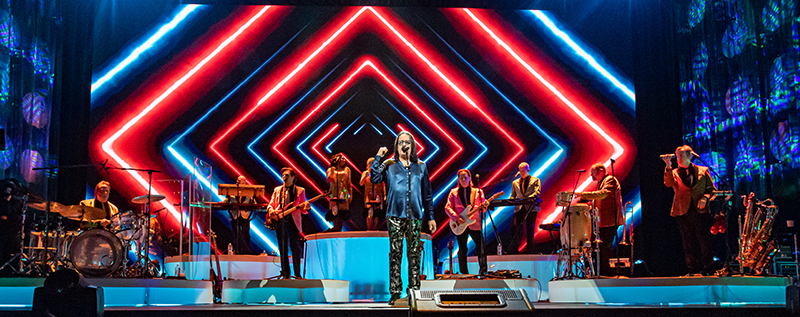
“Sometime around October, we realized that the tour we were supposed to do in February was postponed eight months,” Rundgren says. A conversation would ensue taking him, once again, to the “bleeding edge” of technology. “I wanted as much of a real concert as possible, making this a model for something not just to sell tickets, but be a performer’s experience as well as something for the audience. It is not enough to set up a camera and stream it out and then listen to dead silence when you’re done with a song.” Rundgren’s longtime production manager, Paul Froula, who is based in Chicago, set about vetting venues to begin the process of building this into a reality.
Rundgren made clear that it was not to look like a TV show, and the cameras were to mimic the audience members’ eyes as much as possible. “There are a few close-ups, but naturally you look at the drummer sometimes, or the background singers [etc.],” says video producer Chris Andersen. There were equal considerations for audience and band members. Both needed a “sense of normalcy.”
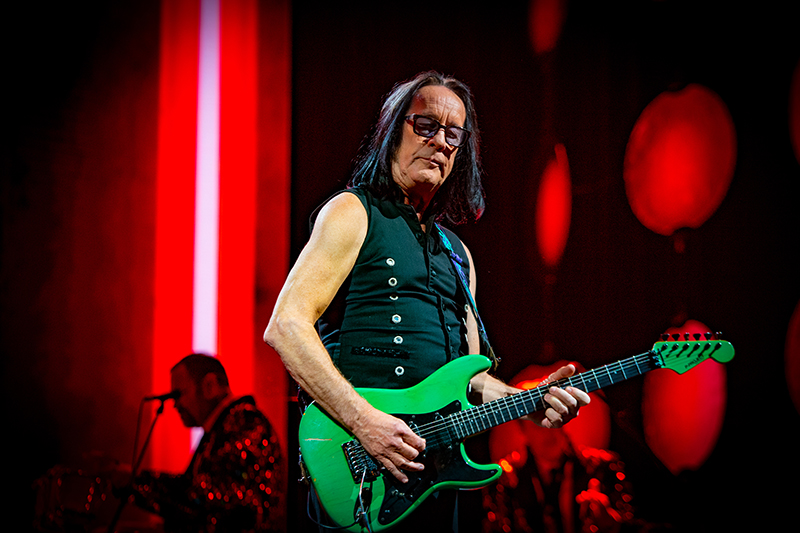
Putting the Gang Back Together
Alex Skowron had been the production designer on Rundgren’s groundbreaking Liars tour in 2004, which was the first-ever 100 percent LED package was on tour (okay, plus one old spotlight). Fast forward to late 2020, when Skowron noticed an article on Rundgren’s idea for the tour and that it was going to be Chicago-based. Skowron, who is based in the Chicago area himself, got in touch with the production team asking if there was anything he could do. “I was put in touch with Paul Froula,” he says. “I then was liaison to lighting designer and director Hans Shoop, taking lists and keeping all the gear sourcing local, budget-minded.” Skowron was able to do that save for risers and decking, which came out of Gallagher Staging’s Nashville office.
Handling video needs was longtime industry executive Todd LePere. LePere, a widely respected account manager, resigned from Solotech in August 2020 and started a new video company in hopes of putting the old team back together. Just after starting Nighthawk Video, LePere got the call from Skowron to put the upstage wall and audience LED package together along with the VIP Greenroom. ”Getting back to our first load-in almost a full year was incredible,” says LePere. “And, even better, we were able to get some old Nocturne-era local crew back to work for the highest quality results.”
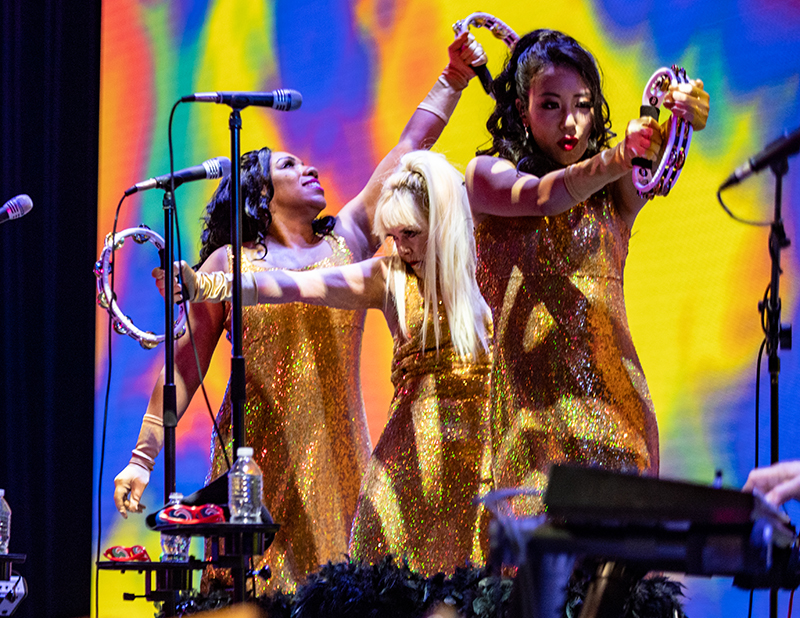
The team was given the goal of “make it live,” meaning the show and the audience. He was given a long leash to figure out how to make it happen. Having that in mind, synergy with band and audience interaction was important. The 17 6’x 2’ Audience LED sections were set up in the bleachers between the limited live crowd, featuring 51 different audience members each in a 2’x2’ section watching from their homes. “This really was exciting to see such a creative, intimate and safe way to reintroduce fans to live music,” says LePere.
Hans says the LED video displays in the audience were tricky because they needed to be bright enough for the band to see the audience on the screens, but not so bright that they become a light source. “We have the levels fairly low, we’re careful not to pollute the stage environment with the light emitting from it. There are a couple of dark moments in the show where we have Abe Main pull it back. In a perfect world we would like to really see the virtual audience as we would the in-person audience and I could have lights on them at all times, but that would make it too bright and distracting to the band. At one point, Todd asked, ‘Why is the audience lit better than me?’” The video company also supplied the large upstage video wall that extended the width of the set.
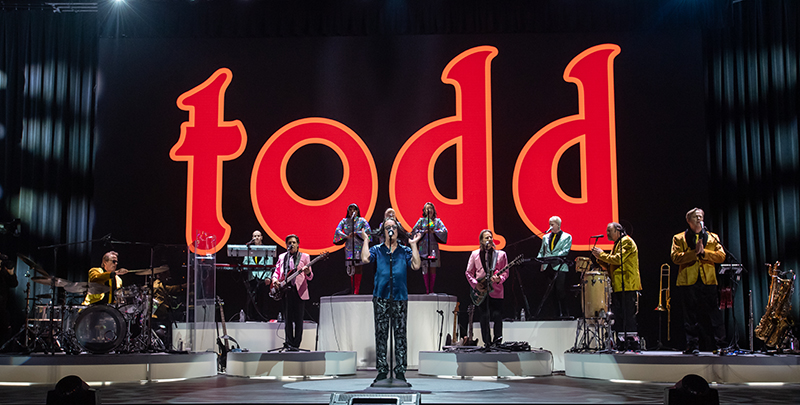
Taking Light
Hans’ first job, of course, is to make sure Rundgren is lit perfectly. “So we opted for the Robe Robospot remote follow spot equipment. We have key light, fill light, and back light, maintaining a constant focus on his movements, while I control the color and intensities. We needed to have key lights on all the band members that matched Rundgren’s color quality and continuity of light, so BMFL Spots were chosen.” Also keeping Rundgren looking good for those 10 cameras are Claypaky B-Eye K20 fixtures. ”The band members each have their own wash fixture to add fill lighting and color to the looks.”
Effect lights include Robe Spikies in pods on the side of the stage. “This is just another thing to give us texture with the scenic pieces, and then we put some more BMFLs on the floor to paint the ceiling.” Compressed CO2 low haze machines were passed over for old-school dry ice ones, which Andersen emphasizes “really looks great” both in person and on camera. Finally, they dusted off an old mirror ball and pointed four Sharpys at it. The audience doesn’t see the actual ball, just the beams that come from illuminating it.
“One thing Hans did that was especially interesting to me was his use of photographic reflectors,” Skowron says. Shoop used mostly oval silver umbrellas that were 30”x54,” which were hung on the sides and run offstage, past the curtains. “It lit nicely for the live stream.” Sourcing all the lighting was a cinch for the team as Skowron has maintained a longtime relationship with Upstaging. He knew the local lighting company would have all the gear he needed in mint condition and in stock, as well as provide a tech to watch over it.
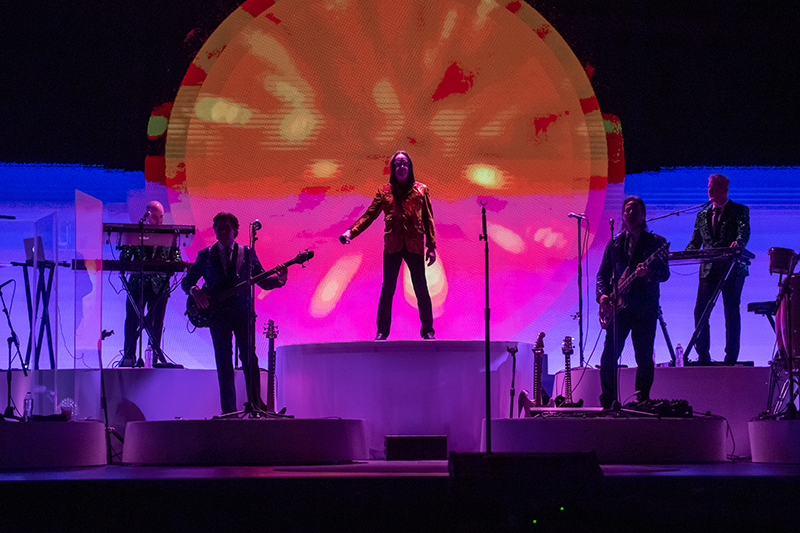
Making the Magic Happen
The idea of an at-home audience being shown on LED screens has been experimented with, which influenced the direction Rundgren would take. “America’s Got Talent has audience participating [this way], and there were ‘faces’ in the crowd of the NBA play-offs, but we wanted to go beyond that and make it audience-focused in a musical event setting,” Rundgren says. “The end results of playing a crowd back live on the video monitors is us seeing real people nodding their heads to the music — it was great.” The size of those heads was “zoomed” to an approximated life-size, and the fact that they were spread in between those live audience members was a neat trick for keeping the in-person audience six feet apart.
“Blending carbon-based life forms with LED screens was interesting,” Froula says. “Some of this stuff hadn’t been done before. Working up the Covid protocol and having to walk through all that was a moving target, too.” For example, they were only allowed 19 “carbon-based” audience members at first, but halfway through the run of shows, the city allowed more. The tour stuck with just 30. One of those was Chicago’s Mayor herself, Lori Lightfoot. “The Mayor is a longtime Rundgren fan — she even used his song ‘Just One Victory’ as her campaign anthem.” That song was not on the set list, but the night she attended, Rundgren made a special exception and played the song in her honor. Froula also chatted with Lightfoot regarding the impact of the Covid crisis on the live entertainment industry, which he says helped “make her more aware of the far-reaching effects on many industries and economies.”
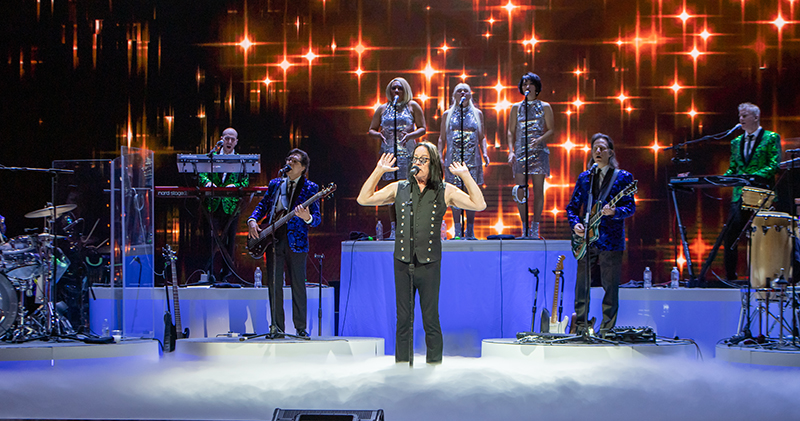
So how does all this translate and transmit? It starts with Andersen, who brought a “fair amount of experience in pay-per-view webcasts” to this experiment. “I would normally have two or three other video techs, but even with just Mike Wiggins and I alone in the truck, it has gone pretty smoothly. My Chicago-based camera crew headed by Mike has been amazing.”
Additional hands were stationed in Lititz, PA. “Clair provides the system to send the composited virtual audience feed over remote NDI. I convert it to HD-SDI, and hand it off to Todd LePere’s team, where the bitmap is decoded and displayed on LED tiles in the front of the band,” Andersen explains. He then generates five streams with stereo audio to livestreaming production company NoCap and Clair for the web distribution. Two are telecast director John Deeney’s line cut, and two others are ISO cameras, usually the FOH and jib, but sometimes the handhelds. “The fifth one is interesting — I call it ‘Crew Cam,’” he says. “Four other cameras show a behind-the-scenes look for the fans in a quad-split. The audio for this feed is Johnny’s intercom camera call and the band crew’s chatter. These shots are great as the fans get to see what goes into making the show.” If you’re thinking this must be a lot of data, you’re right. Andersen says a single performance generates almost three terabytes, and they have a dedicated machine for archiving, which is backed up nightly.
Both Andersen and Shoop agree that there are a couple of big advantages for doing shows in a single room. Top of the list is, they aren’t trying to adapt the set and lights to whatever venue they land in on a given night. Secondly, “This gives us the ability to fine tune the way the director is cutting the show,” Andersen says. “We’re making little changes every day, and it’s fantastic.” Andersen publishes a high-def reference of a show every five or so days for the band and crew to study and make further improvements.
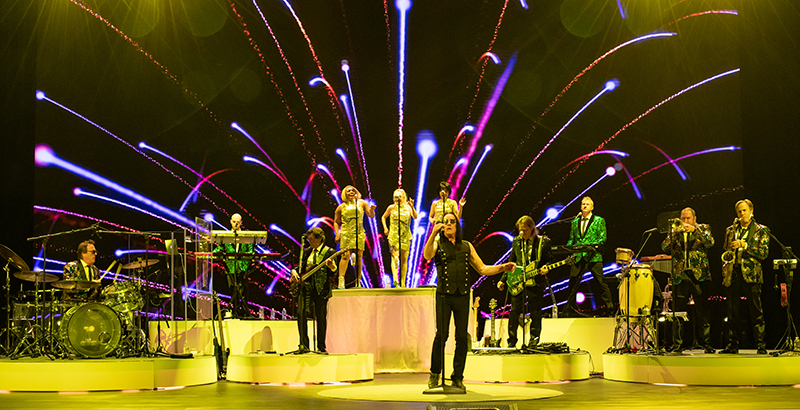
The Future
“You never get something like this right the first time, and we’re always fine tuning it,” Rundgren says. “That’s like a typical tour: The early shows are the best you could do, and two weeks into the tour, it’s better.” As for the end result, “It’s pretty close to what I envisioned, and in some ways it’s beyond it. I was only concerned that it didn’t look like a warehouse, but more like a [music] venue that could be anywhere.”
As to the future, “The pandemic will go, and at some point, we hope to return to live touring as we once knew it. But maybe there will be some who will feel that a virtual aspect is a viable alternative. In the end, it’s about audience response and how they feel about it. I could see a segment of the audience PREFERRING to see a show this way. On our first night I watched a guy on one of the screens chain smoke through the whole show. I’ve seen people dancing with their pets. You can’t do either of those at a live show. Also, the tickets were $35, and for that, a whole family could come. Plus, then the liquor is cheaper!”
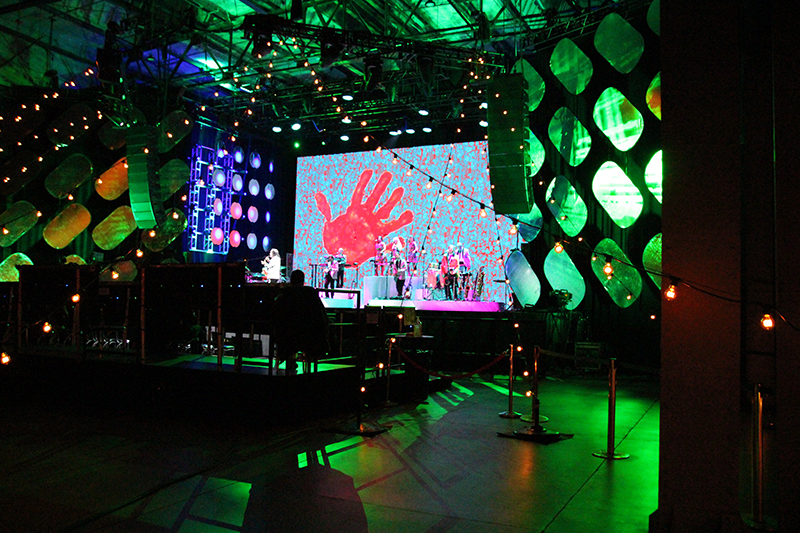
Todd Rundgren’s Clearly Human Live Virtual Tour
Livestreamed from Radius Chicago to 25 U.S. Cities from Feb. 24 to March 22, 2021

Crew
- Production Manager, Tour Manager, Monitor Engineer: Paul Froula
- Video Producer: Chris Andersen/Nevessa Production Woodstock
- Lighting Designer/Director: Hans Shoop
- Production Coordinator: Alex Skowron
- Lighting Co: Upstaging
- Lighting Tech: Nick Phishghadamian
- Video Co: Nighthawk Video/Todd LePere
- Video Crew Chief: Mike Wiggins
- Camera Operators: Ray McGhee Jr., Cory Brookins, Will Haywood, Cameron Frazier, Tim Valentine
- Video Techs: Abe Main, Charlie Alves, Brandon Dolderer, Steve Tomanek, Brian Bateman
- Custom Video Content: Todd Rundgren, Danny Connor, Hans Shoop
- Telecast Director: John Deeney
- Production Assistant/Covid Compliance: Rex Rundgren
- Backline Tech/Stage Manager: Randy Brown
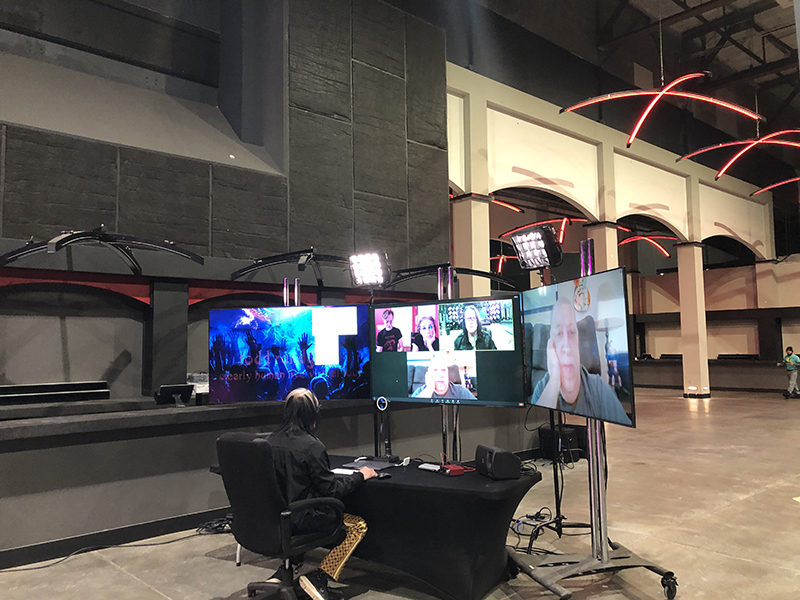
Gear
Lighting:
- 1 grandMA2 console
- 1 grandMA2 Command Wing
- 24 Robe BMFL Spots
- 3 Robe BMFL Spot w/ Cameras
- 4 Claypaky Sharpys
- 24 Claypaky B-Eye 20’s
- 32 Robe Spikies
- 24 SGM Q-7 LEDs
- 640’ Festoon Strings
- 1 20” Mirror Ball w/ADJ DMXII motor
- 100’ HUD Truss
- 28 Motor points
- 2 Dry ice foggers
- 2 Base Hazers
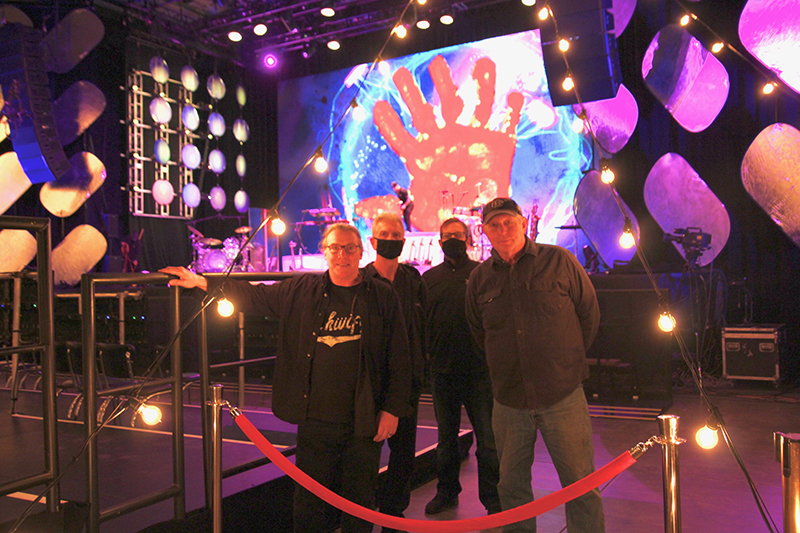
Video:
1 ROE BP3 upstage wall (42.5’ x 24.5’ HxW; 4K processors
17 ROE CB5 panels for the audience LED/6’ x 2’ each
3 70” monitors and computers for the VIP green room
